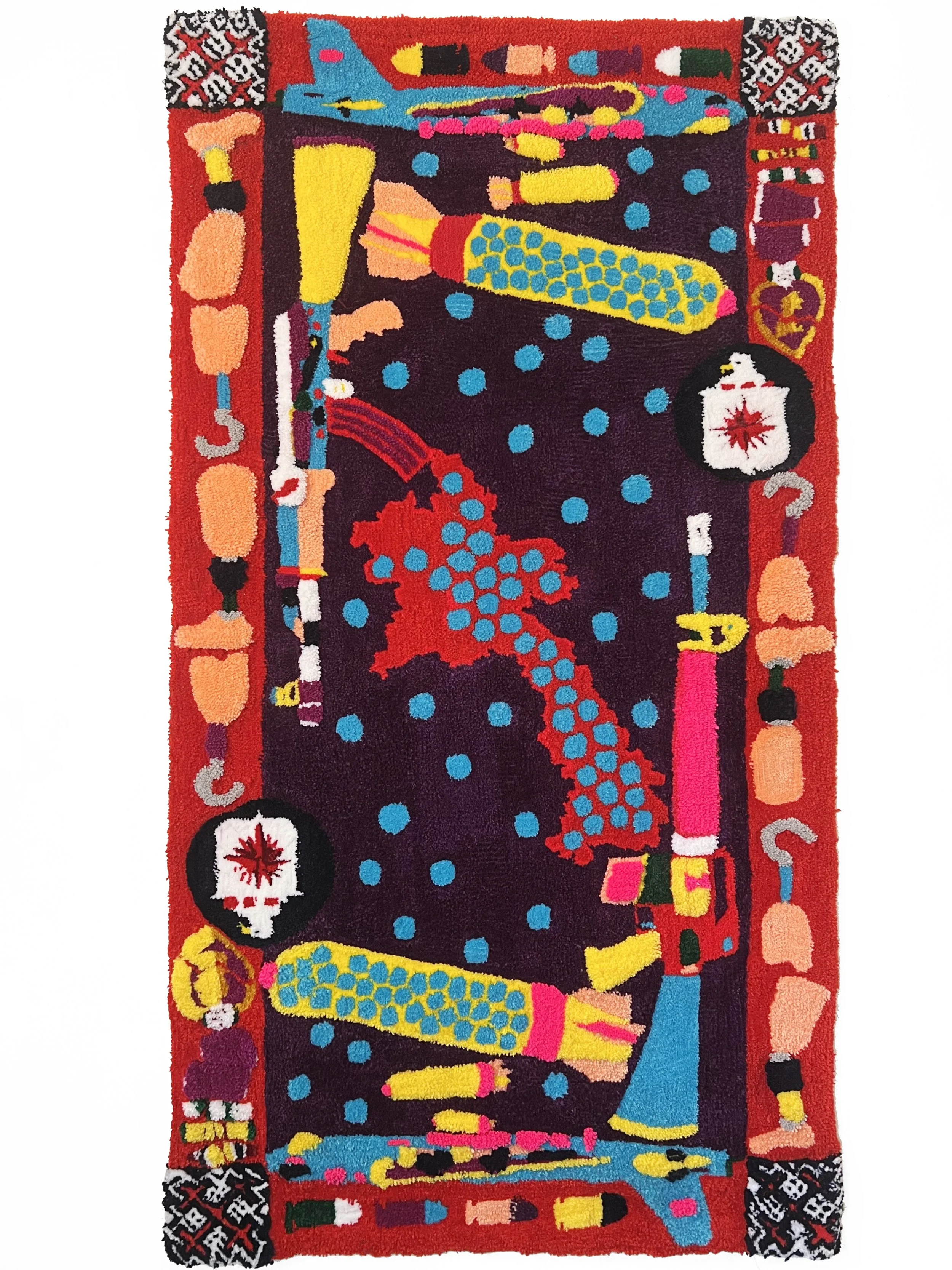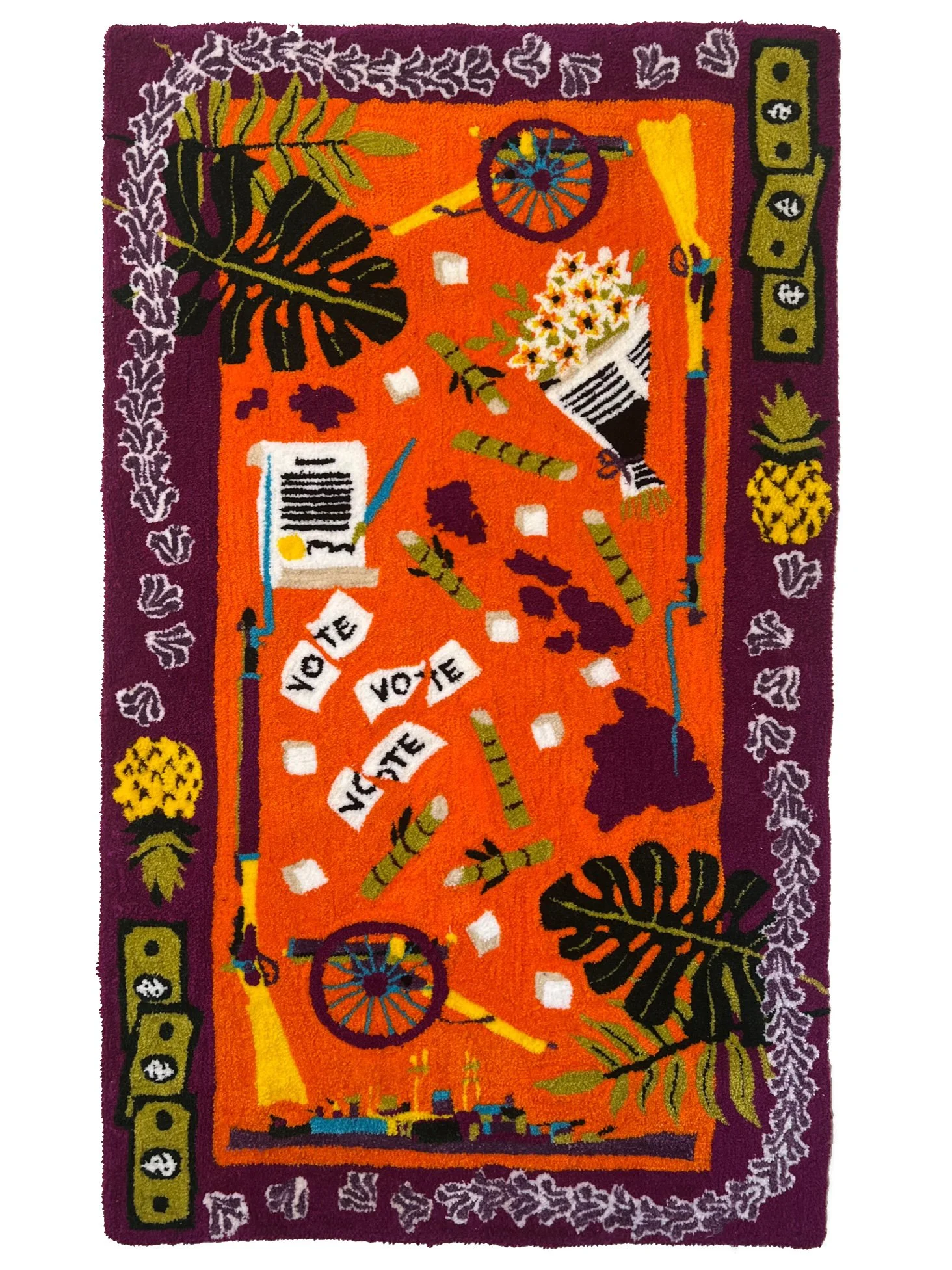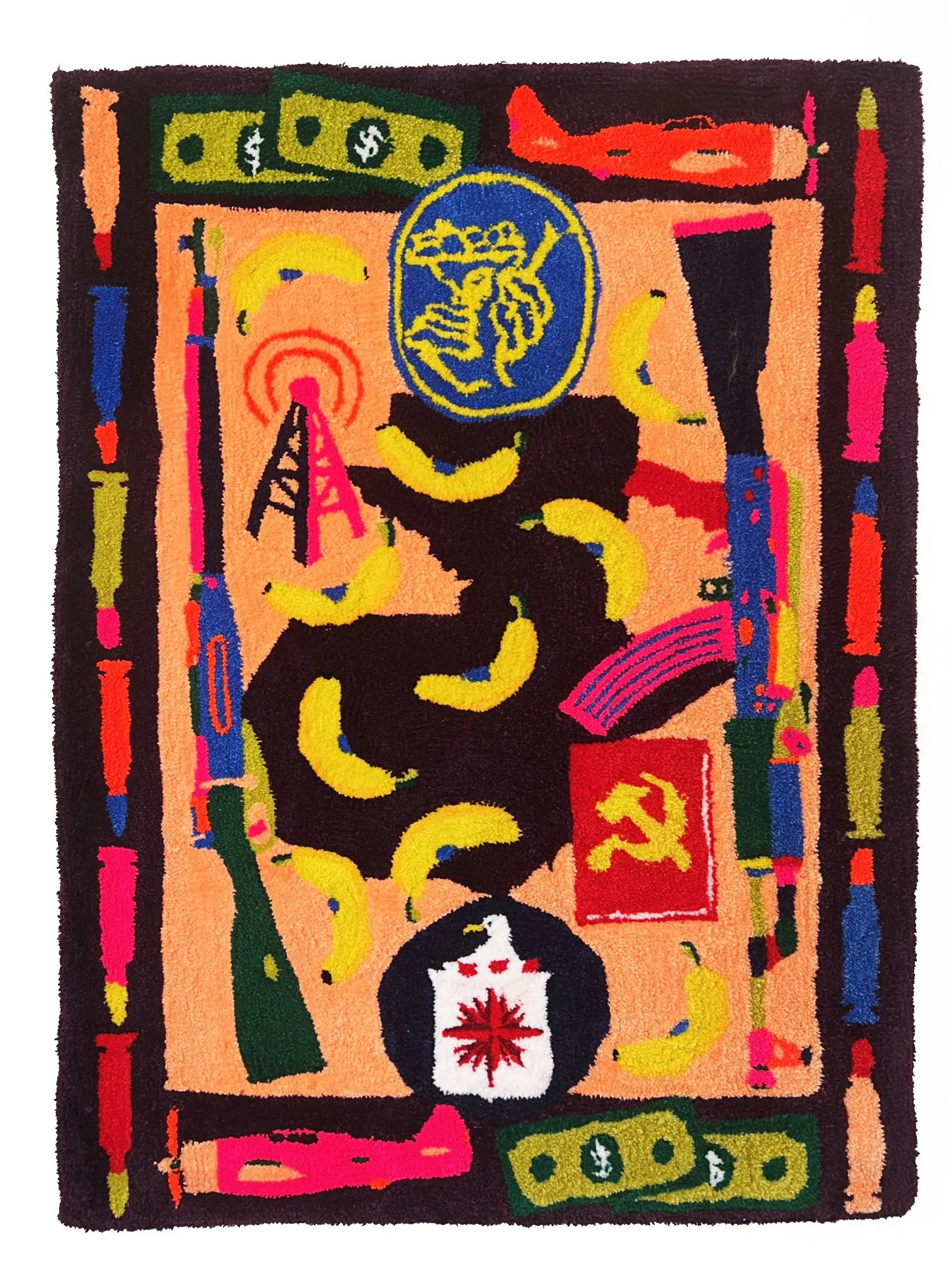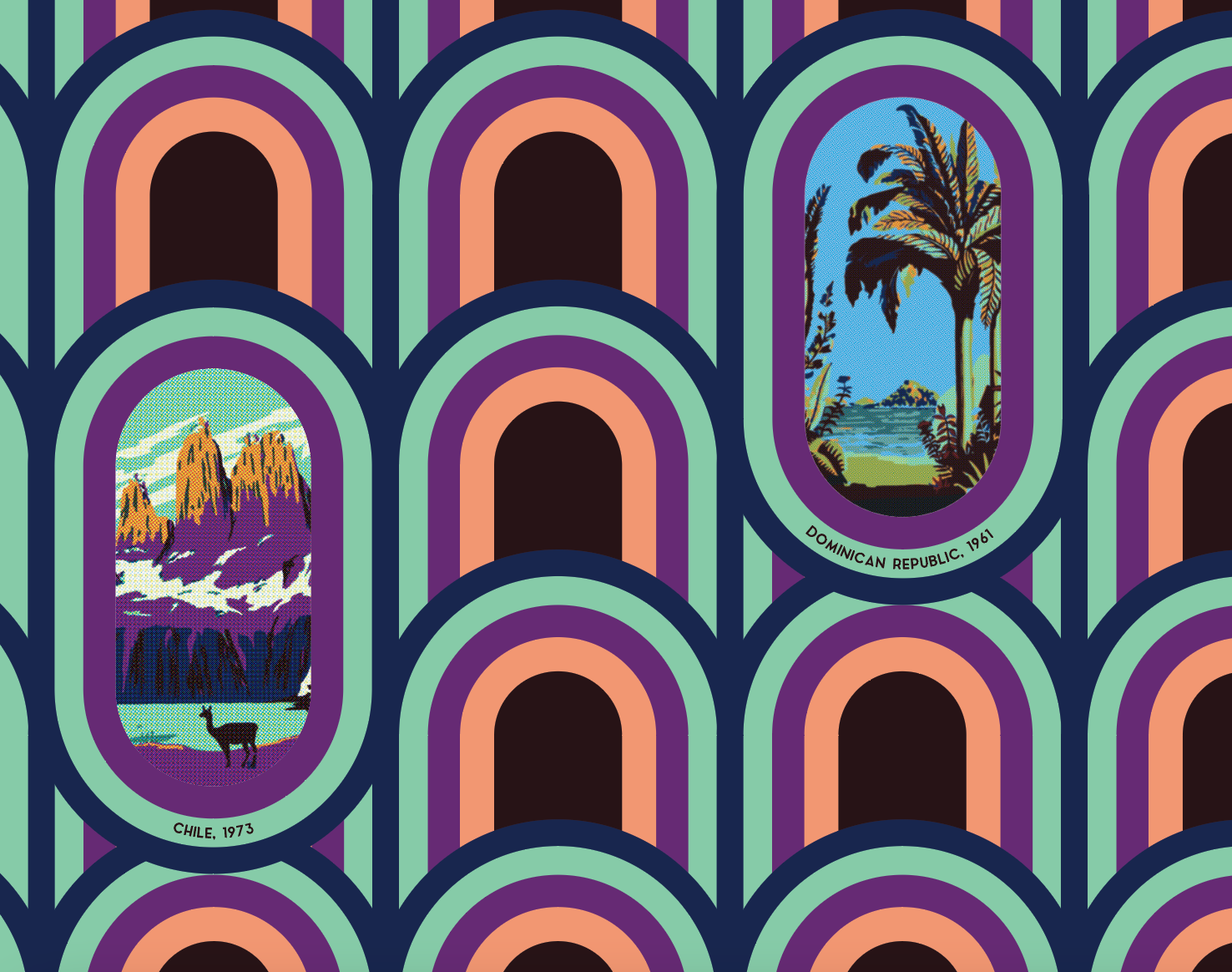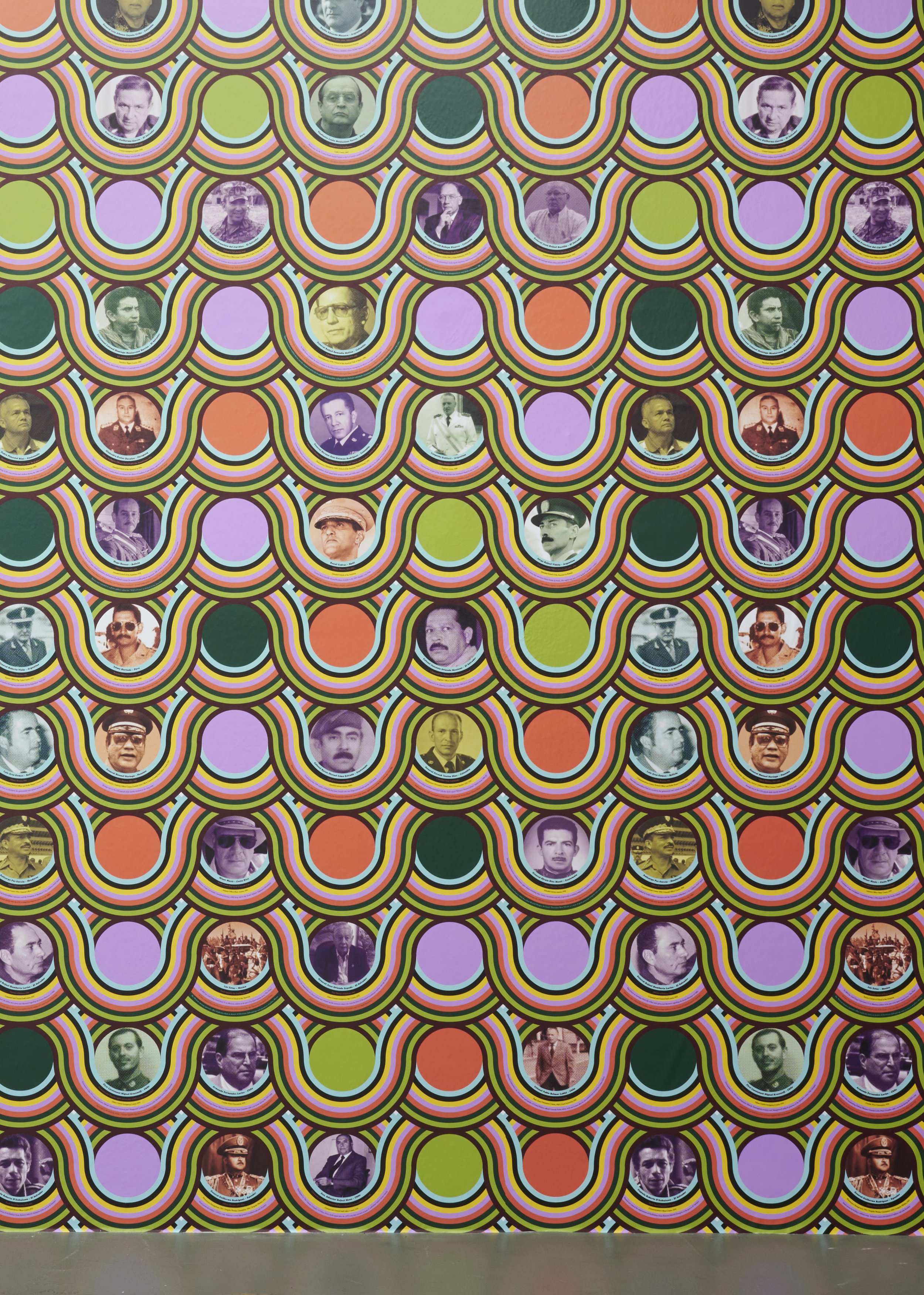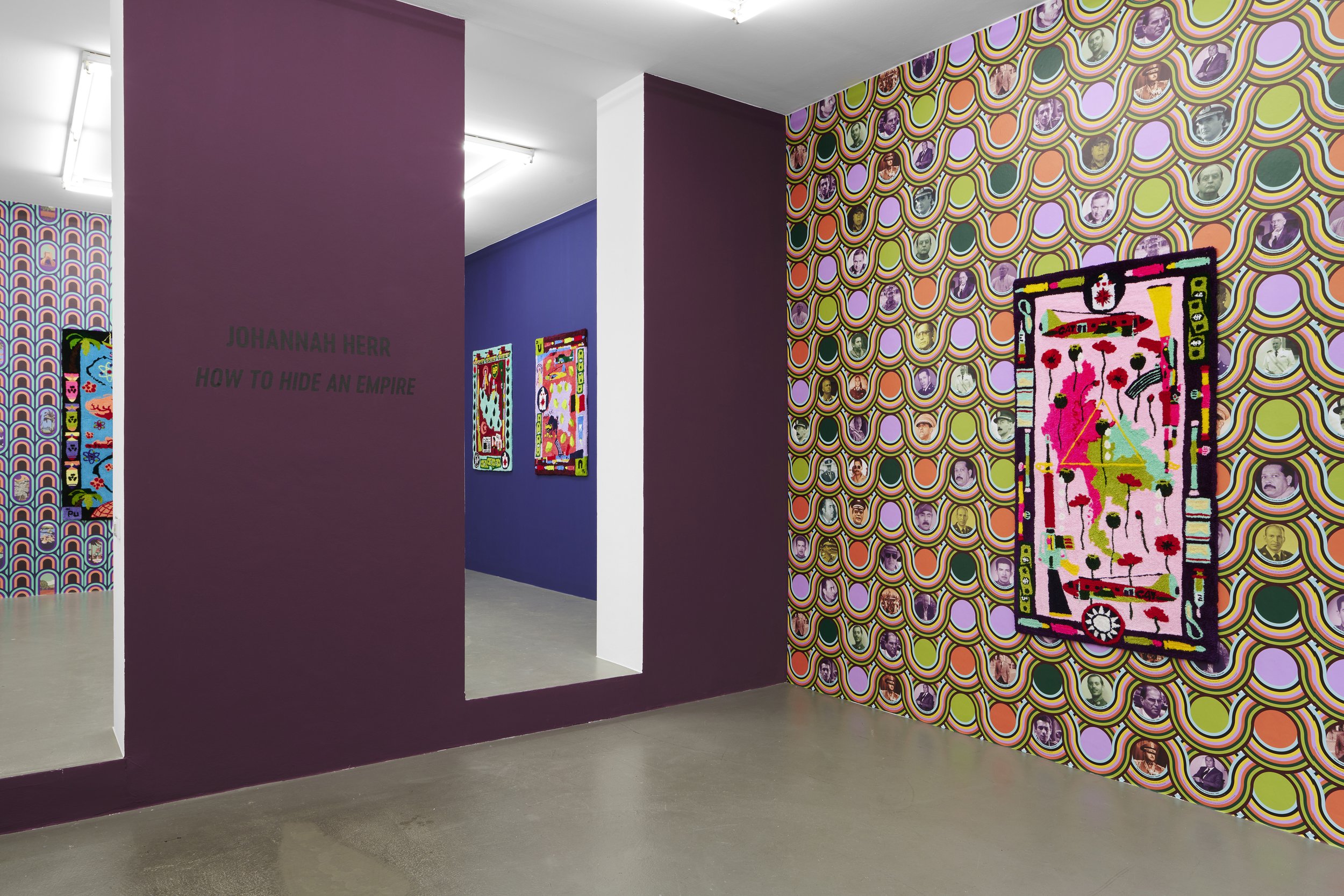
How to Hide an Empire
2022 | GAA Gallery | Cologne, Germany
How to Hide an Empire presents a body of work concerned with forgotten or unseen US imperialist aggression. The exhibit is comprised of subversive, digitally printed wallpaper and machine-tufted rugs that utilize the visual strategies of Afghan war rugs. The rugs are a continuation of my War Rugs From America series, which subvert an artform that, in Afghanistan, was used to document the Soviet and subsequent American invasions, only to be sold back to invading soldiers as a commodity. Each rug features a historical moment when the US stepped outside of its sovereign borders to meddle in a foreign land—whether via proxy wars during the Cold War and/or to support the overthrow of legitimate governments unfriendly to US business interests. The exhibition draws attention to the inherent hypocrisy of a country that pretends to be a bastion of democracy yet tramples the rights of foreign citizens and undermines democratically elected governments everywhere.
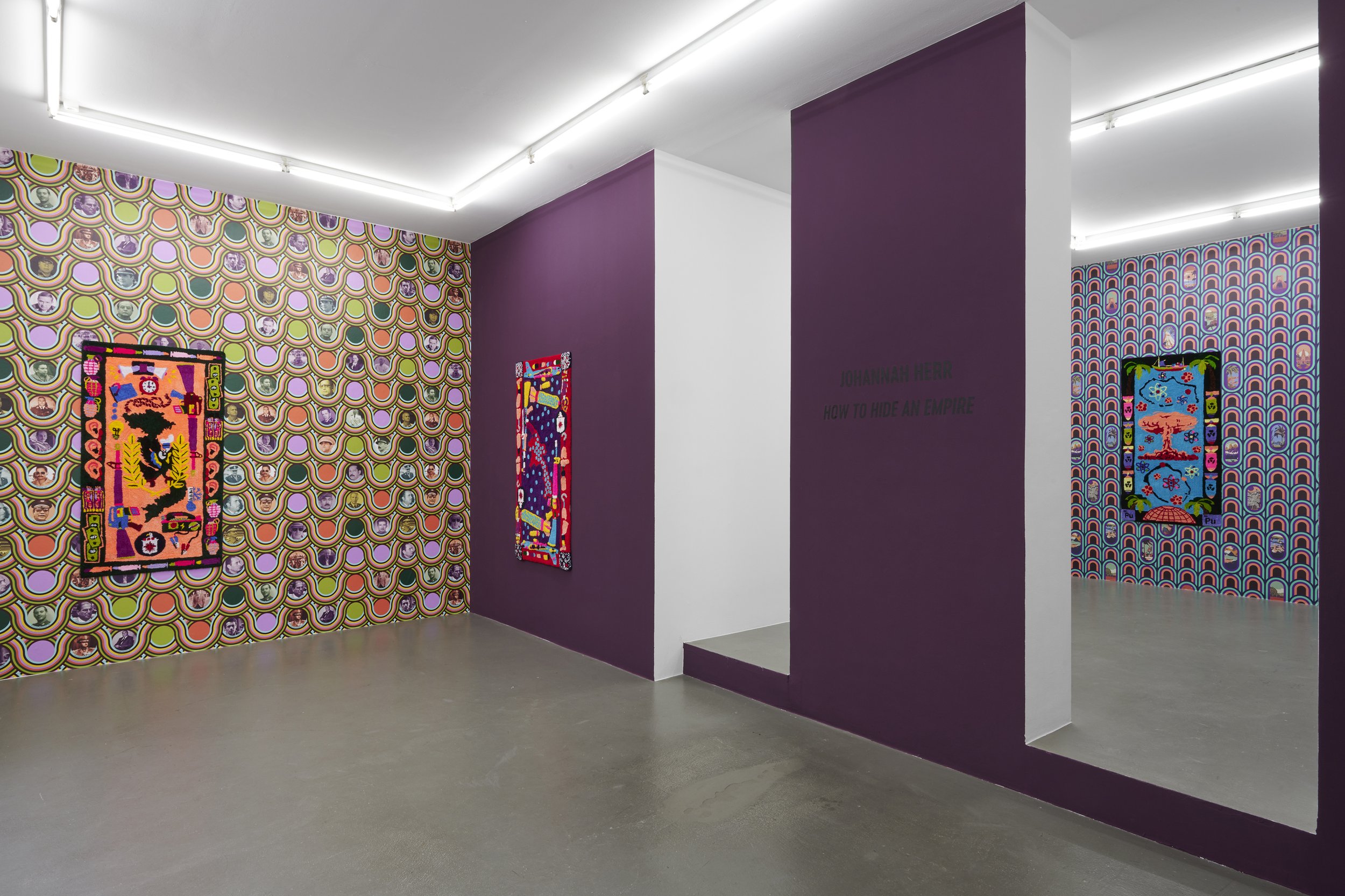
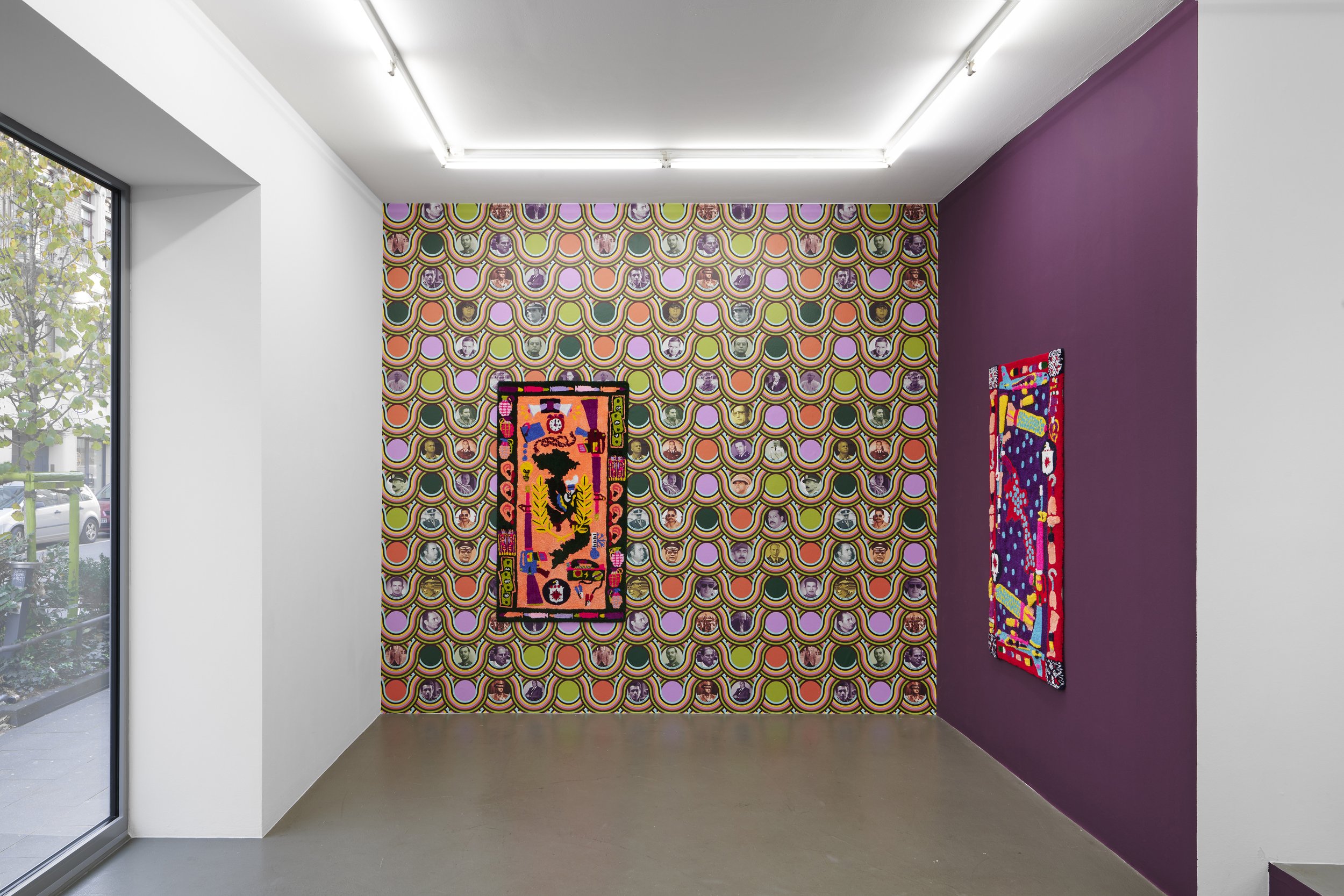


These particular rugs speak to lesser-known events. Importantly, historical events that were either deliberately committed in secret by the CIA or purposefully obfuscated from the American public in order to maintain the mythology of the US as a “good actor” in the world. Also, several of the rugs have a direct through-line to contemporary events. For example, one rug references Operation Paper—the first time the US worked with anti-communist rebel groups that funded themselves via drug trafficking, a model replicated later in Mexico, Colombia, and Afghanistan in which the US created a drug trade to criminalize certain behaviors and control various populations. Another rug addresses the dark legacy of The Phoenix Program, which was the first time the US codified torture and torture of civilians into our official policy.
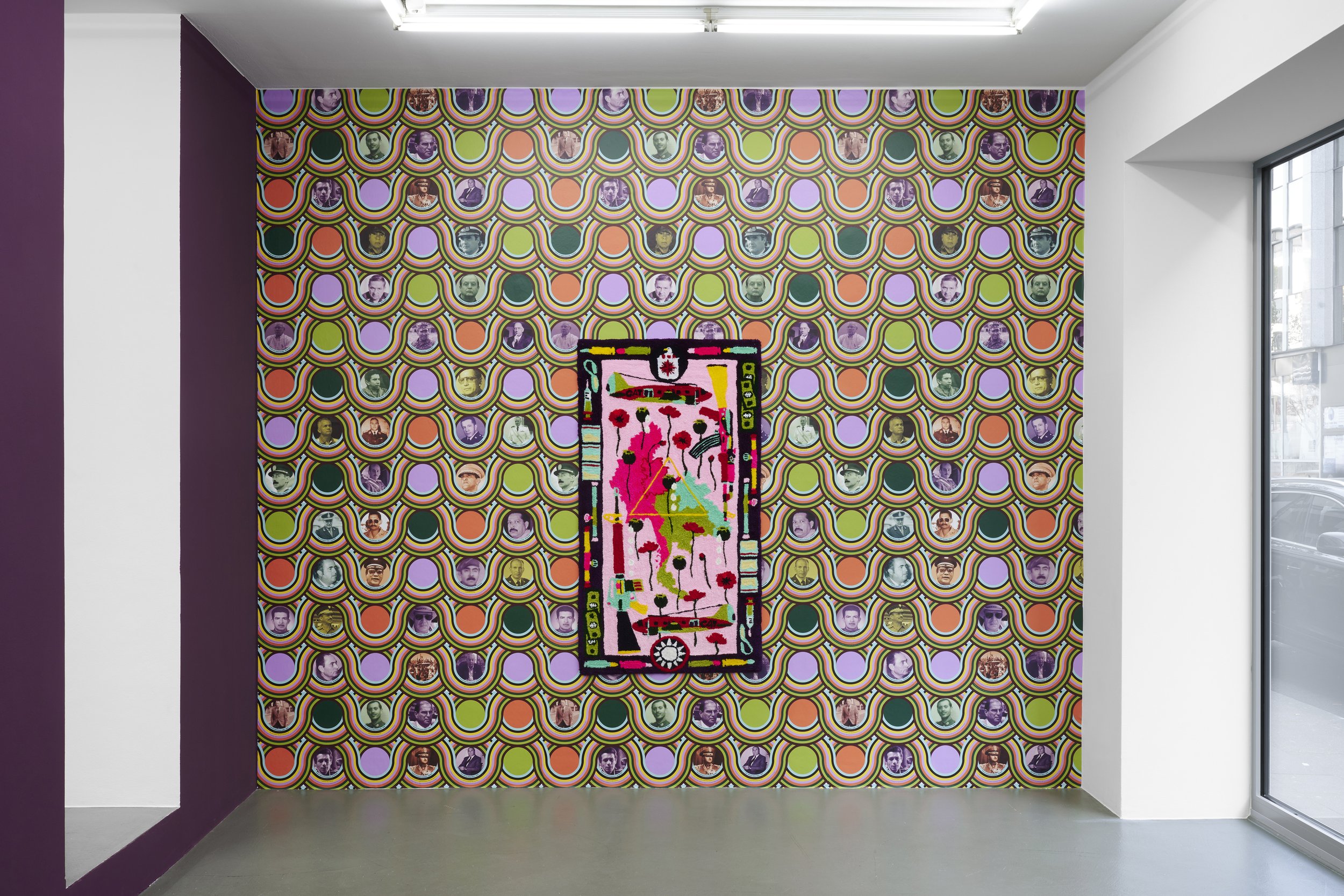
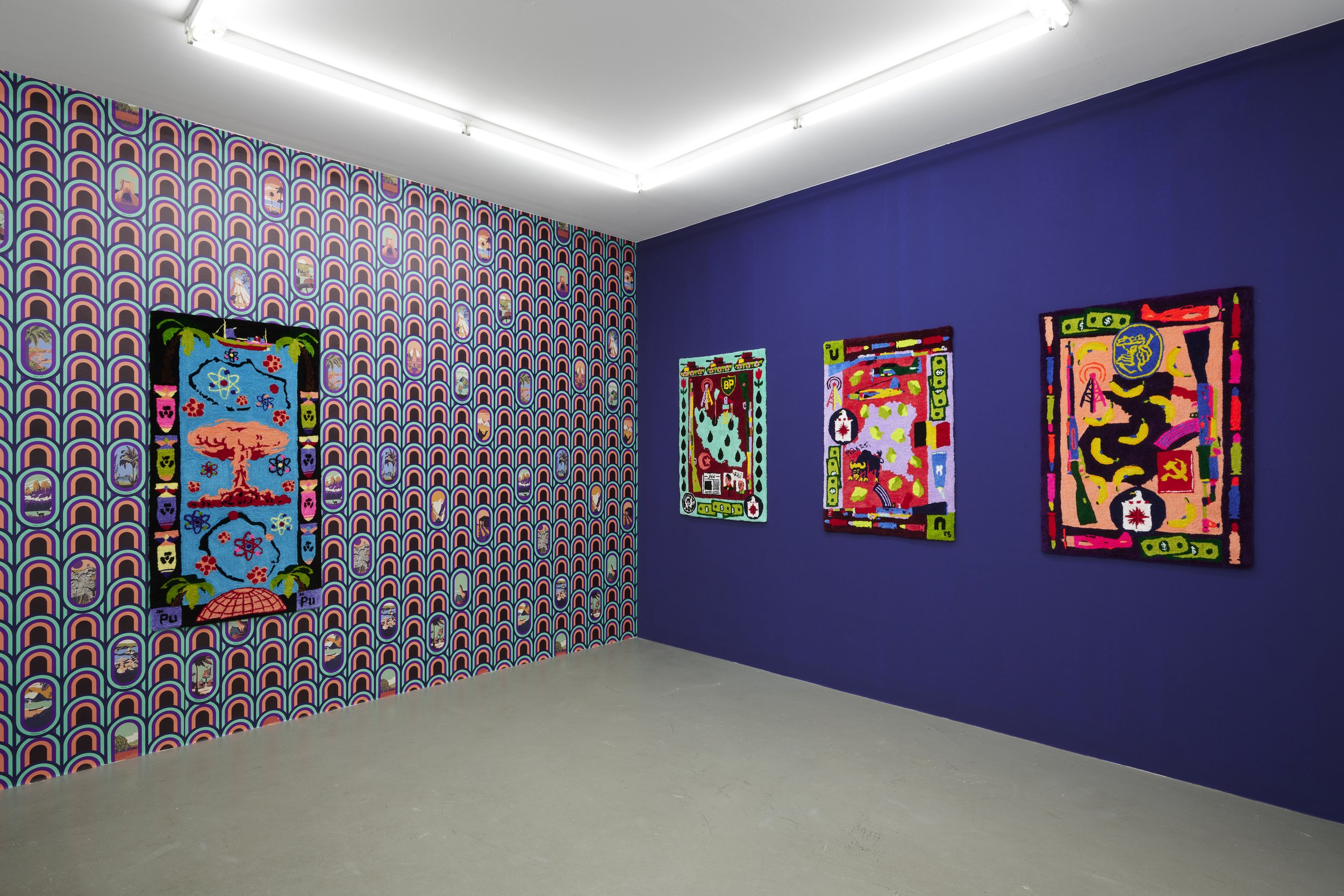
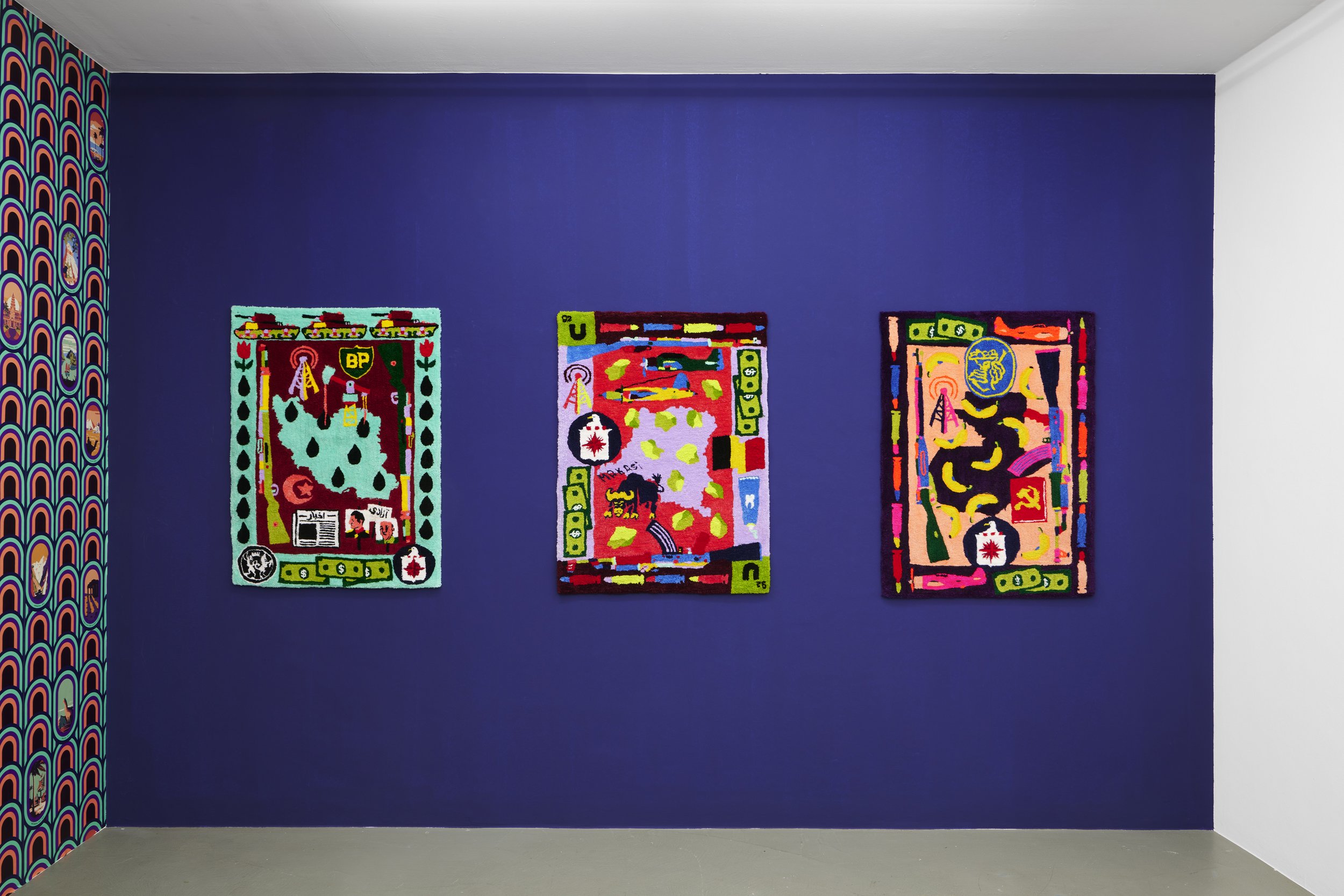
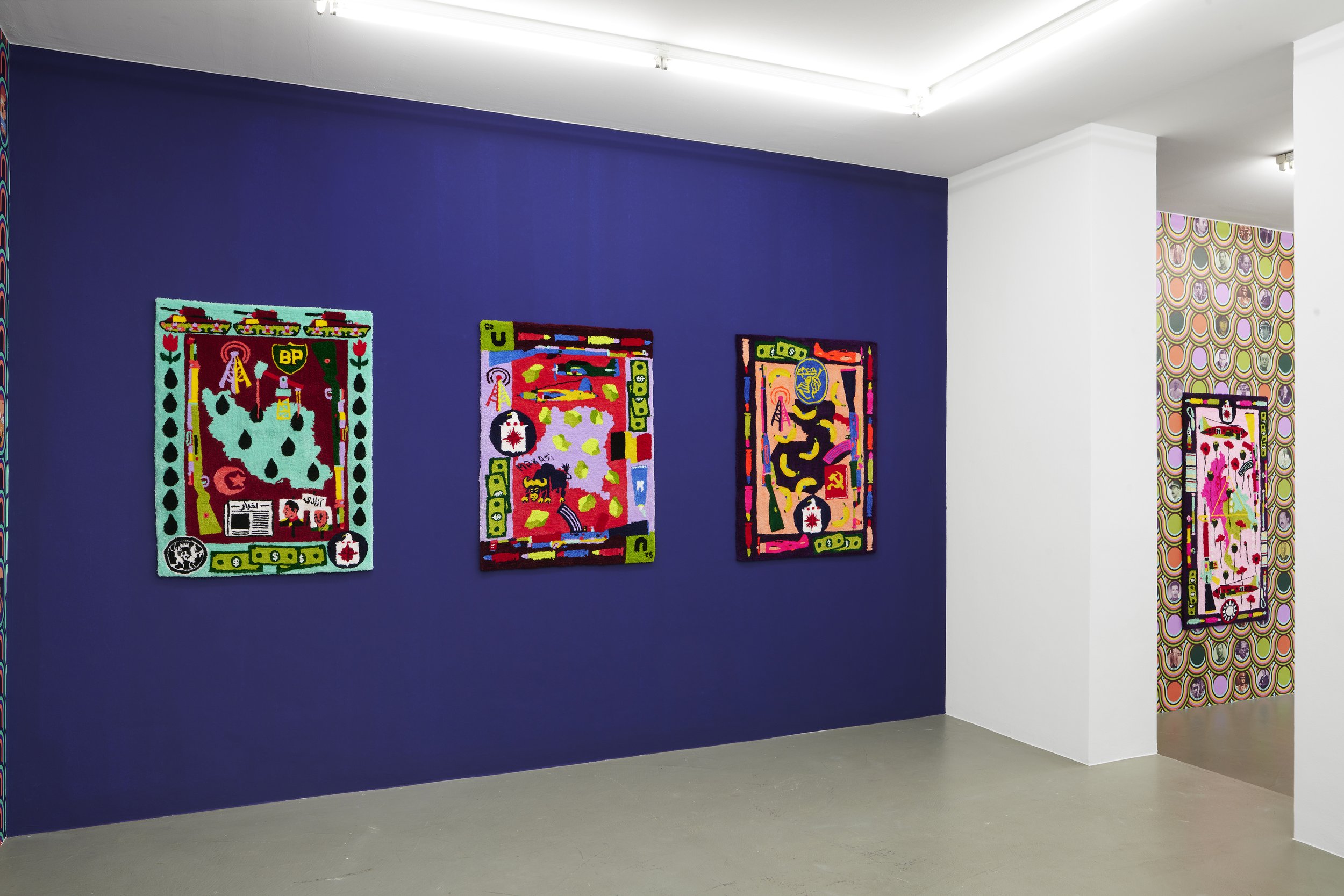
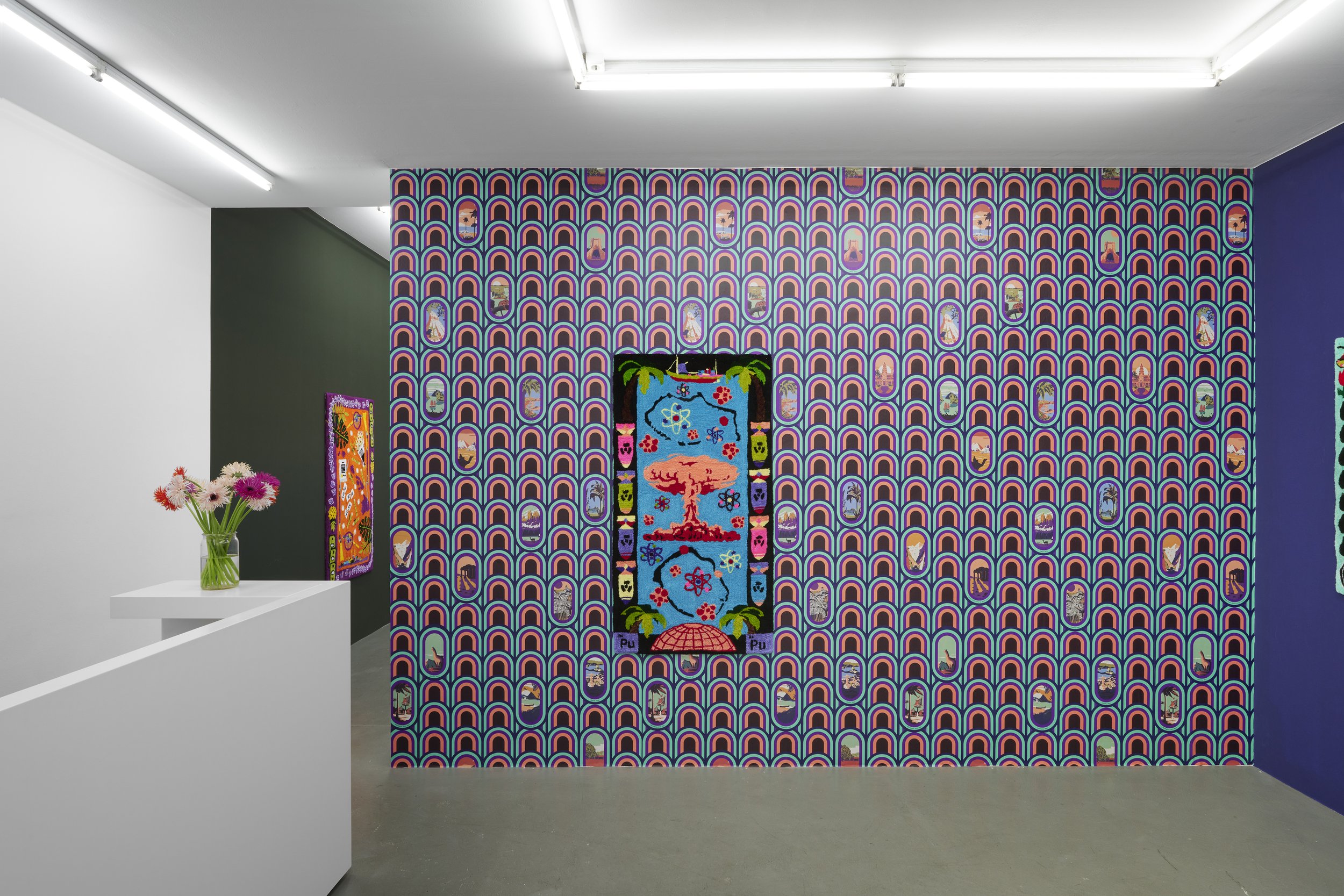
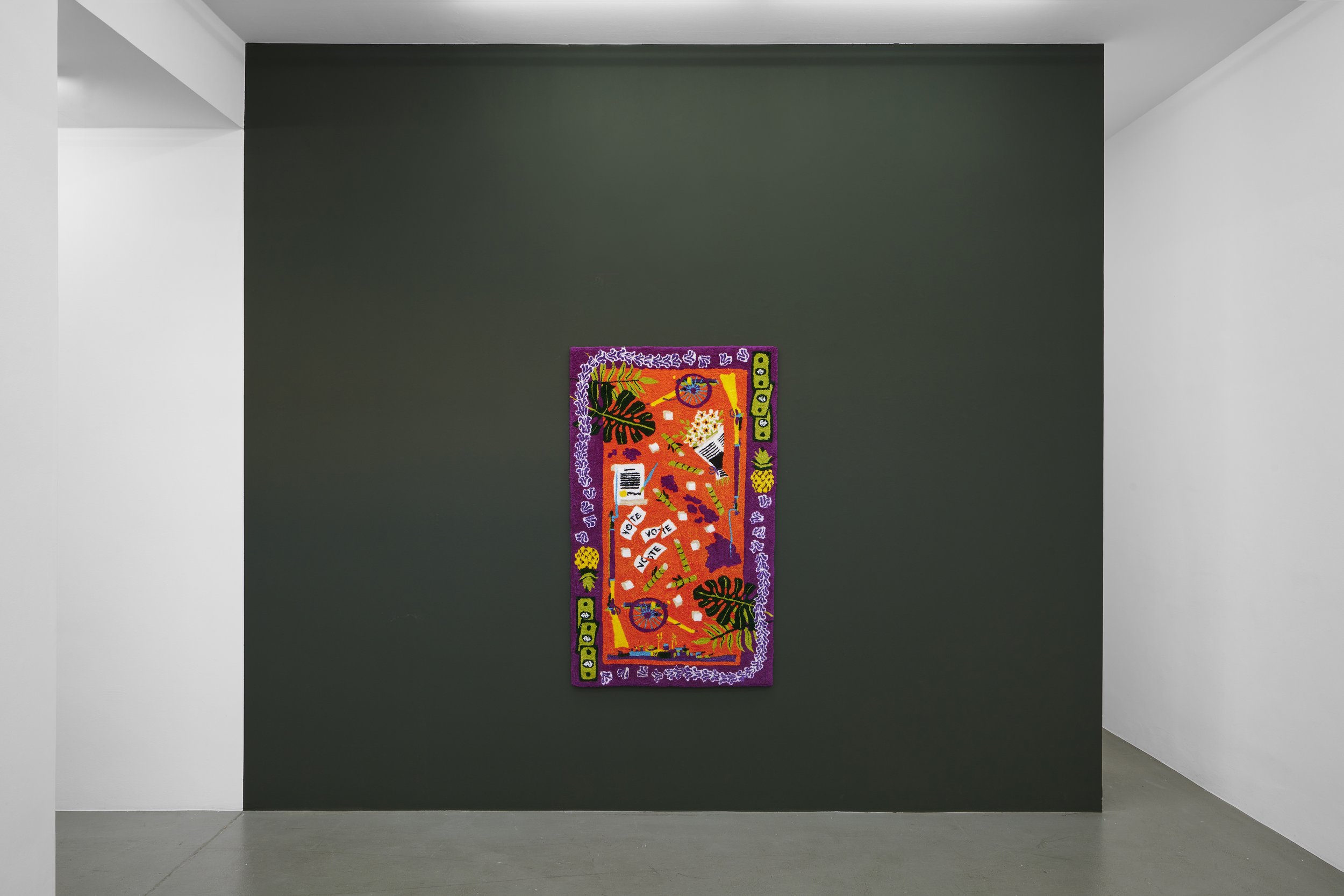
American War Rug XVIII (Phoenix Program)
2022, 61" x 33", tufted rug using acrylic and wool yarn
Rug references the CIA’s Phoenix Program which tortured and assassinated Vietnamese civilians suspected of being VietCong Infrastructure during the Vietnam War. The torture techniques developed in this program were then used extensively in the War on Terror (even though their efficacy for gaining accurate intelligence was proven ineffective) and later written into the curriculum of the US’s School of the Americas, a military training program that would graduate a large number of military officials who would go on to commit crimes against humanity during Operation Condor and the “Dirty Wars” in South America in the 1970’s.
Iconography includes: map of Vietnam, Phoenix Program and CIA logos, US currency, alarm clock, light bulb and loudspeakers (referencing sleep deprivation as a torture technique), bucket of water (waterboarding), rope, thermometer (the cells of detainees were often kept at frigid temperatures), “Tucker Telephone” (a shock-torture device originally created by physician A. E. Rollins, the resident physician at the Tucker State Prison Farm, Arkansas in the 1960s and then adapted during the Phoenix Program for use with a military field telephone), grenades, severed ears (Phoenix personal were tasked with quotas of Vietcong they had ‘neutralized’ and would bring back severed ears as a way of proving their quota numbers), logic boards from the IBM 1401 computer (the first computer used for intelligence surveillance), M16 rifles and bullets.
American War Rug XI (Secret War in Laos)
2022, 63in x 33in, tufted rug using acrylic and wool yarn
Rug references the history of the CIA’s secret proxy war in Laos (1964-1973) during which the US dropped more than 270 million cluster bombs on the the country (more than all of the bombs dropped in WWII combined). Due to Laos’s dense jungle foliage many of these bombs failed to detonate and to this day over 80 million munitions have yet to be cleared from the land, resulting in countless injuries, deaths and loss of limbs. During the conflict the US collaborated with guerilla fighters from the Hmong ethnic minority group, however afterwards the US failed to recognize their service, denying them military awards and veterans benefits. In the aftermath of the conflict the Hmong’s support of the US during the war also made them the targets of ethnic cleansing by the Laotian armed forces.
Iconography includes: Map of Laos, cluster bombs, AK47 and M16 rifles, bullets, CIA logos, B52 Bombers, Hmong Hill Tribe patterning, prosthetic limbs, and broken military medals; Purple Heart, Vietnam Service, Republic of Vietnam Campaign, and National Defense Service Medals.
American War Rug XV (Operation Paper)
2022, 63" x 34", tufted rug using acrylic and wool yarn
Rug references the history of Operation Paper, the CIA-backed support of anti-communist KMT troops operating out of Myanmar that funded their operations by trafficking opium. The CIA created Air America (CAT) as a front organization to help rebels fly arms in and fly drugs out of Shan State in Myanmar and Thailand. Operation Paper played a major role in creating the Golden Triangle of opium trade in Myanmar, Thailand, and Laos. It also supported rebel groups who funded their enterprises with drug trafficking–which became a model that would be used again in Colombia, Mexico and Afghanistan, leading to increased narcotrafficking in all of those countries as a pretense for US invasion.
Iconography includes: map of Myanmar, Thailand and Laos (with Shan State in Myanmar outlined), CIA and KMT logos, milking poppy plants, bags of heroin, heroine drug paraphernalia and opium pipes, US currency, C46 Airplane for Civil Air Transport (CAT), AK47 and M16 rifles, bullets.
American War Rug XVI (Marshall Islands, 1946-58)
2022, 63" x 33", tufted rug using acrylic and wool yarn
This rug references the history of US Nuclear testing on the Marshall Islands. Beginning with Operation Crossroads the US forcibly displaced Marshallese to conduct nuclear testing. Over the course of 12 years, the United States conducted 67 nuclear tests in the Marshall Islands: 23 at Bikini Atoll and 44 near Enewetak Atoll, but fallout spread throughout the Marshall Islands, resulting in the contamination of land and water on many of the atolls, and high cancer rates throughout the Marshallese population. In the 1954 Castle Bravo test, the US miscalculated and fallout blew the across populated atolls as well as gave acute radiation poisoning to the crew of the Japanese fishing boat the Daigo Fukuryū Maru (this disaster as well as the Marshall Islands nuclear testing would later be the inspiration for the Japanese Godzilla character’s origin story). In the 1970s the US then used one of the craters created during the Castle Bravo test to dump plutonium and radioactive waste from nuclear testing in Nevada, covering it over with a cement dome called The Runit Dome (or The Tomb by locals). However the dome was never properly sealed and now with rising ocean waters due to climate change is ripe for an even greater nuclear contamination disaster.
Iconography includes: maps of Bikini and Enewatak Atolls, nuclear blast mushroom cloud, nuclear bombs, cancer cells, and the Japanese plutonium, the Runit Dome (known as a “nuclear coffin”).
American War Rug XVII (Hawaii, 1893)
2022, 63" x 36" machine-tufted rug with acrylic yarn
Rug references the history of the US overthrow of the Hawai’ian monarchy lead by Queen Lili’uokalani in 1893. The coup was led by the Committee of Safety, a group of 13 foreign residents and non-native Hawaiian subjects of American descent, lead by sugar mogul Sanford Dole, who wanted control of the government to protect their sugar plantations with the ultimate goal of annexation by the US. Originally seizing power in an 1887 revolt where they forced Lili’uokalani’s brother (then king) to sign a constitution stripping the monarchy of its power (called the Bayonet Constitution), when Lili’uokalani came to power they staged a coup against her—with the support of the US Hawaiian diplomat John Stevens and the marines of battleship USS Boston—putting her under house arrest. After she was released from house arrest, Lili’uokalani petitioned the US to reinstate her power, to which President Cleavland agreed. However Sanford Dole flatly refused to follow Cleavland’s orders and held out until Cleavland’s successor McKinley came to power. McKinley who saw Hawaii as a strategic location in the Pacific and annexed it in 1898.
Iconography includes: map of Hawai’i, broken crown flower lei (the crown flower was preferred by Queen Liliuokalani), flowers wrapped in newspaper (when under house arrest Liliuokalani was restricted from accessing news so supporters would bring her flowers wrapped in newspaper), torn voting ballots, Winchester 1886 rifles with bayonets, gatling guns, sugar cane and sugar cubes, US currency, pineapples, and battleship USS Boston.
American War Rug XII (Iran, 1953)
2022, 48" x 34" machine-tufted rug with acrylic yarn
Rug references the history of the 1953 CIA-backed coup in Iran. The coup was a joint effort with British intelligence (MI6) (code-named Operation AJAX and Operation Boot, respectively). These acts were sparked by Prime Minister Mohammad Mosaddegh's nationalization of Iranian oil reserves which stripped the Anglo-Iranian Oil Company (later BP) of their industry monopoly. While there was a military component to the coup—Mosaddegh stepped down after a tank fired into his compound—the overthrow was largely orchestrated through an intense propaganda campaign, the bribing of prominent Iranian government leaders and Islamic clerics and orchestrations of protests both for and against the Shah.
Iconography includes: Map of Iran, 1953 British Petroleum logo (formerly Anglo-Iranian Oil), CIA and MI6 logos, M1310 Mauser rifles, Radio Tehran radio tower, oil rig and oil drops, crescent moon and star, protest signs with Prime Minister Mohammad Mosaddegh and the Shah, Mohammad Reza Pahlavi, newspaper, US currency, tanks, tulip (Iranian symbol of martyrdom).
American War Rug XIV (Congo, 1961)
2022, 48" x 34", tufted rug using acrylic yarn
Rug references the US-backed 1961 coup in The Congo and the assassination of then president Patrice Lamumba. The CIA colluded with the Belgian Government to orchestrate this coup—for which Belgium formally apologized in 2022. A significant factor in the US’s interest in the region was The Congo’s mineral wealth–particularly uranium deposits they feared would fall into Soviet hands without a leader friendly to US interests. As part of the overthrow, the US created a Congolese air force using surplus WWII airplanes, piloted by Cuban dissidents who had participated in the failed Bay of Pigs Invasion. In exchange for their aviation skills, the US promised the Cubans that they would make a second attempt to overthrow Castro’s regime–a promise never realized after President Kennedy’s assassination.
Iconography includes: map of The Congo, Makasi Air Force bull logo (the Cuban pilots gained the name ‘makasi’ or “strength” in Lingala), CIA logo, US currency, Belgian flag, poisoned toothpaste (the CIA unsuccessfully attempted to assassinate Patrice Lamumba with poisoned toothpaste), Uranium ore, B-26 Marauder and T-28 Trojan planes, AK47 and FN 1889/39 Belgian Congo Mauser rifles and bullets.
American War Rug XIII (Guatemala, 1954)
2022, 48" x 34", tufted rug using acrylic yarn
This rug references the history of the 1954 CIA-backed coup in Guatemala. The coup was orchestrated in collusion with the United Fruit Company (later Chiquita Brands International) whose profits were threatened when President Jacobo Arbenz expropriated their land to landless peasants. The ousting of Arbenz was crafted through a multifaceted propaganda campaign to portray Arbenz as a communist threat (though he had no ties to Moscow) orchestrated by United Fruit’s consultant Edward Bernays (known for inventing the field of Public Relations) including a fake rebel radio station called Radio Liberación, staged “documentation” of battle scenes leaked to US press, a CIA-trained, funded and armed rebel group, and bombing of Guatemala City with US Air Force planes.
Iconography includes: Map of Guatemala, Chiquita (Formerly United Fruit) and CIA logos, AK47 and Mosin-Nagant rifles, bullets, Marxist literature, Radio Liberación radio tower, US currency, P-47 Thunderbolt planes.
Cold War Coup Wallpaper
Open edition, archivally printed vinyl removable wallpaper
Wallpaper includes imagery inspired by midcentury travel posters from 17 countries in which the US backed coups to overthrow democratically elected governments during the Cold War era: Cuba (attempted in 1961) Guatemala (1954), Indonesia (1957 and again in 1965), Chile (1973) Bolivia (1971), Laos (1960), Congo (1960), South Vietnam (1963), Granada (1983), Brazil (1964) Iran (1953), Argentina (1976), Egypt (1952) Syria (attempted in 1949, 1956, 1957) Guyana (1964), Dominican Republic (1961), and Syria 1949, 1956/1957 (attempted). These are the countries that are confirmed by the CIA through declassified documents while there are several others that are suspected to have been CIA-orchestrated.
Friendly Tyrants (School of the Americas) Wallpaper
Open edition, archivally printed vinyl removable wallpaper
Wallpaper includes faces of 50 graduates of the US’s School of the Americas, a military training program (originally based in Panama) that trained foreign military personnel in US strategies of war with the aim of gaining anti-communist allies in the global south. Torture techniques developed in The Phoenix Program and propaganda + guerilla fighting strategies from CIA-backed coups were a significant part of the curriculum. The 50 graduates featured on this wallpaper would then go on to become brutal right-wing dictators, military generals, and paramilitary death squad leaders in South America, giving the school its morbid nickname, “Escuela de Asesinos” or “School of the Assassins.”

